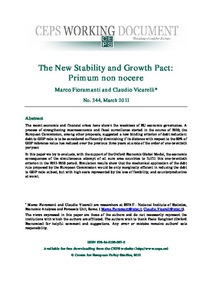The new Stability and Growth Pact: primum non nocere
"The recent economic and financial crises have shown the weakness of EU economic governance. A process of strengthening macroeconomic and fiscal surveillance started in the course of 2010; among other proposals, the European Commission suggested a new binding criterion of debt reduction: debt-t...
| Main Authors: | , |
|---|---|
| Institution: | ETUI-European Trade Union Institute |
| Format: | TEXT |
| Language: | English |
| Published: |
Brussels
2011
CEPS |
| Subjects: | |
| Online Access: | https://www.labourline.org/KENTIKA-19177897124919950799-The-new-Stability-and-Growth-P.htm |
| Summary: | "The recent economic and financial crises have shown the weakness of EU economic governance. A process of strengthening macroeconomic and fiscal surveillance started in the course of 2010; among other proposals, the European Commission suggested a new binding criterion of debt reduction: debt-to-GDP ratio is to be considered sufficiently diminishing if its distance with respect to the 60% of GDP reference value has reduced over the previous three years at a rate of the order of one-twentieth per year.
In this Working Document, ISTAT Researchers Marco Fioramanti and Claudio Vicarelli try to evaluate, with the support of the Oxford Economic Global Model, the economic consequences of the simultaneous attempt of all euro area countries to fulfil this one-twentieth criterion in the 2011-2015 period. Simulation results show that the mechanical application of the debt rule proposed by the European Commission would be only marginally efficient in reducing the debt to GDP ratio at best, but with high costs represented by the loss of flexibility, and counterproductive at worst." |
|---|---|
| Physical Description: | 9 p. Digital |

